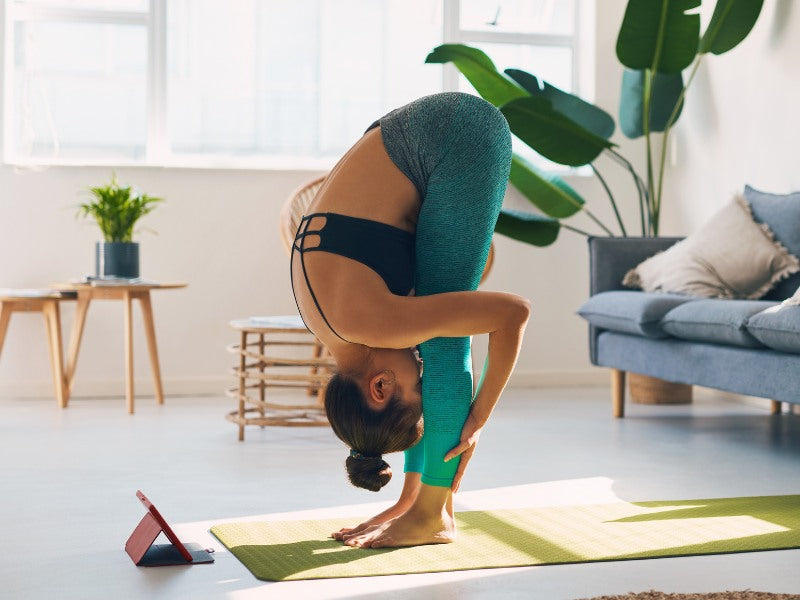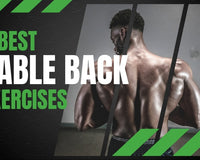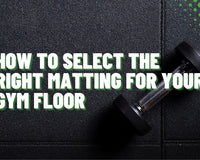Picture your hips as the engine of your body. When that engine purrs, you sprint faster, jump higher, and lift heavier. When it sputters, everything from picking up groceries to pulling deadlifts turns into a grind.
Hip hinge exercises keep that engine tuned, and today we will give them the spotlight they deserve.
By the time you finish reading, you will feel ready to hinge like a champion and maybe crack a smile while you are at it. Let’s go over the best hip hinge exercises right now.

What Are Hip Hinge Exercises?
A hip hinge is a movement that lets your hips fold and reset while your spine stays neutral.
Think of it as closing and opening a door at the hip joint. Your torso tilts forward, your backside moves backward, then you press through the floor to stand tall again.
During a good hinge your knees bend just enough for balance and comfort, your shoulders remain tucked, and your back stays perfectly straight. If you have ever performed a deadlift, kettlebell swing, or even bowed politely, you have already performed a hip hinge exercise.
Related Post: Warm Up Properly Before Lifting Weights
Benefits Of Hip Hinge Exercises
Hip hinge exercises have several benefits, including the following:
-
First, hinging builds raw strength along the entire backside, otherwise known as the posterior chain. Strong glutes and hamstrings push you forward in every sport and protect your knees in daily life.
-
Second, hinging teaches your spine to stay firm while your hips do the work. That means fewer “uh-oh” moments when you pick up a wiggly toddler or a heavy suitcase.
-
Third, the hinge is sneaky cardio. Moves like kettlebell swings can spike your heart rate in record time, giving you a muscle and conditioning combo that coffee cannot beat.
-
Finally, hip hinge practice carries over to squats, lunges, and even fine movements like golfing or swinging a bat.
What Muscles Do Hip Hinge Exercises Work?

Let’s take a quick look at the muscles doing a hip hinge motion works.
-
Glutes act as the main engine, stretching on the way down and propelling you back up.
-
The hamstrings work right behind them, pulling the hips into alignment and steadying your knees.
-
Your spinal erectors keep your spine from rounding.
-
The lats grip the weight close, stabilizing the upper body.
-
Core muscles brace everything so that power moves in one clear line from foot to hand.
-
Even calves, adductors, and upper back do some work.
Related Post: 7 Horizontal Pull Exercises
Who Should Do Hip Hinge Exercises?
Hip hinges are ideal for everyone!
-
Strength trainees who want bigger deadlifts or better kettlebell swings need it.
-
Office workers who sit all day benefit from the stretch and activation a hinge provides.
-
Seniors who wish to keep their lower backs safe during daily chores gain stability from hinge practice.
-
Beginners love hinges because they learn proper lifting mechanics early, and seasoned lifters love them because they unlock new strength records.
Best Hip Hinge Exercises
Before we jump into the exercise parade, remember one golden rule: quality over quantity. Start light, nail form, and only then add load. Ready? Let us meet the top ten.
1. Bodyweight Hip Hinge

The bodyweight hip hinge is perfect for beginners who need to program correct motor patterns without any load.
Steps
-
Stand with feet hip-width apart and soften your knees.
-
Brace your core and pinch your shoulder blades.
-
Push your hips straight back while keeping your head in line with your spine.
-
Stop when your chest points to the floor and you feel a hamstring stretch.
-
Drive your feet into the ground, squeeze your glutes, and return to standing.
Related Post: Are Deadlifts a Back or Leg Exercise?
2. Kettlebell Deadlift

The kettlebell deadlift is great for lifters who want to bridge the gap between bodyweight hinges and barbell deadlifts. They’re perfect for garage gym lovers.
Steps
-
Place a kettlebell between your feet.
-
Hip hinge down and grab the handle with both hands.
-
Pack your lats by pulling the kettlebell toward your body.
-
Press through your heels and stand tall while squeezing glutes.
-
Lower with control by hinging again and parking the bell.
3. Dumbbell Romanian Deadlift

These are excellent for hamstring growth and for those who want symmetry because dumbbells force each side to work equally.
Steps
-
Hold two dumbbells at thigh level with palms facing your body.
-
Brace your core and tilt your pelvis forward as you push hips back.
-
Keep the dumbbells close to your legs and lower until your torso is almost parallel to the ground.
-
Press hips forward until you reach standing, then repeat for reps.
Related Post: Erector Spinae Exercises
4. Barbell Conventional Deadlift

This is the king of strength builders. It’s deal for lifters aiming for full body power and a thicker back.
Steps
-
Walk to the bar so that it runs over mid foot.
-
Grip the bar just outside your knees.
-
Set your back flat, lift your chest, and push the floor away.
-
Stand up until hips and knees lock while eyes face forward.
-
Return the bar with the same hinge path, parking it gently.
5. Trap Bar Deadlift

This gives newcomers a friendly setup since handles are at the sides, reducing lower back stress. Athletes love it for easier positioning.
Steps
-
Step inside the trap bar and grab the handles.
-
Sit your hips back and keep shins vertical.
-
Drive through your feet to stand while keeping shoulders relaxed.
-
Lower until plates kiss the floor.
-
Reset and repeat.
6. Kettlebell Swing

The kettlebell swing is a cardio and power superstar. Busy lifters use it for quick conditioning, and athletes use it for hip snap speed.
Steps
-
Start with the kettlebell a foot in front.
-
Hike it back between your legs like a football snap.
-
Snap your hips forward, letting the bell float to chest height.
-
Keep arms straight and let gravity bring it back.
-
Repeat while maintaining a rhythmic breathing pattern.
7. Single Leg Romanian Deadlift

The single leg Romanian deadlift is great for balance and ironing outside imbalances. Runners adore it for hip stability.
Steps
-
Hold a dumbbell in the hand opposite the working leg.
-
Slightly bend the working knee and tip your torso forward as the free leg extends behind you.
-
Keep hips level and back flat.
-
Stand tall by pressing through the midfoot and squeezing the glute.
-
Perform all reps, then switch legs.
8. Barbell Hip Thrust

If glutes are the goal, this is your ticket. Figure competitors and sprinters both swear by it.
Steps
-
Sit on the floor with a bench behind you and barbell over your hips.
-
Roll the bar into position and lean upper back against the bench edge.
-
Plant feet shoulder width with shins vertical.
-
Drive hips up until torso and thighs form a line.
-
Pause, squeeze glutes, then lower hips to tap the floor lightly.
9. Cable Pull Through

The cable pull through is ideal for learning the hip snap and for lifters who need a back friendly hinge. It’s great during deload weeks.
Steps
-
Attach a rope handle to a low cable pulley and face away.
-
Straddle the rope so it is between your legs and grab both ends.
-
Walk out to create tension.
-
Push hips back letting the rope follow.
-
Fire hips forward until you stand straight, rope ending in front of your thighs.
10. Good Morning

The good morning is a gem for upper back strength and hamstring length. Powerlifters use it to boost squat stability.
Steps
-
Position a light bar on the meat of your traps.
-
Stand tall with feet hip-width.
-
Soften knees and hinge forward, keeping chest proud.
-
Stop at a safe range where you still control the load.
-
Drive hips forward to return to the starting stance.
Rounding Up
Hip hinge moves keep your backside strong and your lower back safe. Pick a few of the nine exercises, focus on good form, and train them two or three times a week.
Start light, stay tight through your core, and add weight only when every rep looks the same. Do that and you will lift better, move better, and feel better every day.





